A Novel Stochastic Two-Stage DEA Model for Evaluating Industrial Production and Waste Gas Treatment Systems
Abstract
:1. Introduction
2. Literature Review
3. Proposed Stochastic Two-Stage DEA Model
4. Empirical Analysis and Results
4.1. Variables Selection and Data Description
4.2. Efficiency Analysis
4.2.1. Efficiency Comparison between Deterministic and Stochastic Two-Stage Models
4.2.2. Sensitivity Analysis of
4.2.3. Evaluation from the Regional Perspective
4.2.4. Efficiency Comparison between Proposed Stochastic Two-Stage Model and Corresponding Stochastic Single-Stage Model
5. Conclusions
Author Contributions
Funding
Conflicts of Interest
Appendix A. Stochastic Single Stage DEA Model
References
- Zhou, Z.; Guo, X.; Wu, H.; Yu, J. Evaluating air quality in China based on daily data: Application of integer data envelopment analysis. J. Clean. Prod. 2018, 198, 304–311. [Google Scholar] [CrossRef]
- Langrish, J.P.; Bosson, J.; Unosson, J.; Muala, A.; Newby, D.E.; Mills, N.L.; Blomberg, A.; Sandström, T. Cardiovascular effects of particulate air pollution exposure: time course and underlying mechanisms. J. Intern. Med. 2012, 272, 224–239. [Google Scholar] [CrossRef] [PubMed]
- Alimu, M.; Salipu, A.; Wang, Y.F.; Tang, C.Y.; Han, C.Y. A Study on the Efficiency of Medical and Health Resource Allocation in the Five Northwest Provinces and the Five Central Asian Countries against the Background of “One Belt and One Road”—An Empirical Study Based on the Three-Stage DEA Model. J. Lanzhou Univ. (Social Sci.). 2016, 4, 90–94. [Google Scholar]
- Zhang, Q.; Tong, J.X. Analysis of Urban Infrastructure Efficiency of the Provinces and Cities on the Belt and Road Area—Based on DEA and Malmquist Index Model. Soft Sci. 2016, 30, 114–117. [Google Scholar]
- Zhang, X.Q. Analysis on the coordinated development of regional logistics in the “One Belt and One Road”. Stat. Decis. 2016, 8, 108–110. [Google Scholar]
- Zhang, W.B.; Deng, L.; Yin, C.B. Evaluation of Green Economy Efficiency and Analysis of Influencing Factors in Major Node Cities of “One Belt and One Road”. Inq. Econ. Issues. 2017, 11, 84–90. [Google Scholar]
- Zhou, Z.; Wu, H.; Song, P. Measuring the resource and environmental efficiency of industrial water consumption in China: A non-radial directional distance function. J. Clean. Prod. 2019, 240, 118169. [Google Scholar] [CrossRef]
- Kao, C. Efficiency measurement and frontier projection identification for general two-stage systems in data envelopment analysis. Eur. J. Oper. Res. 2017, 261, 679–689. [Google Scholar] [CrossRef]
- Charnes, A.; Cooper, W.; Rhodes, E. Measuring the efficiency of decision making units. Eur. J. Oper. Res. 1978, 2, 429–444. [Google Scholar] [CrossRef]
- Desimone, L.D.; Popoff, F. Eco-efficiency: the business link to sustainable development. Crop. Environ. Strategy. 2000, 1, 220–221. [Google Scholar]
- Rashidi, K.; Saen, R.F. Measuring eco-efficiency based on green indicators and potentials in energy saving and undesirable output abatement. Energy Econ. 2015, 50, 18–26. [Google Scholar] [CrossRef]
- Wang, K.; Lu, B.; Wei, Y.-M. China’s regional energy and environmental efficiency: A Range-Adjusted Measure based analysis. Appl. Energy 2013, 112, 1403–1415. [Google Scholar] [CrossRef]
- Sun, J.; Li, G.; Wang, Z. Technology heterogeneity and efficiency of China’s circular economic systems: A game meta-frontier DEA approach. Resour. Conserv. Recycl. 2019, 146, 337–347. [Google Scholar] [CrossRef]
- Song, M.; Wang, S.; Cen, L. Comprehensive efficiency evaluation of coal enterprises from production and pollution treatment process. J. Clean. Prod. 2015, 104, 374–379. [Google Scholar] [CrossRef]
- Bian, Y.; Yang, F. Resource and environment efficiency analysis of provinces in China: A DEA approach based on Shannon’s entropy. Energy Policy 2010, 38, 1909–1917. [Google Scholar] [CrossRef]
- Piao, S.-R.; Li, J.; Ting, C.-J. Assessing regional environmental efficiency in China with distinguishing weak and strong disposability of undesirable outputs. J. Clean. Prod. 2019, 227, 748–759. [Google Scholar] [CrossRef]
- Wu, F.; Fan, L.; Zhou, P.; Zhou, D. Industrial energy efficiency with CO2 emissions in China: A nonparametric analysis. Energy Policy 2012, 49, 164–172. [Google Scholar] [CrossRef]
- He, Q.; Han, J.; Guan, D.; Mi, Z.; Zhao, H.; Zhang, Q. The comprehensive environmental efficiency of socioeconomic sectors in China: An analysis based on a non-separable bad output SBM. J. Clean. Prod. 2018, 176, 1091–1110. [Google Scholar] [CrossRef] [Green Version]
- Kang, Y.Q.; Xie, B.C.; Wang, J.; Wang, Y.N. Environmental assessment and investment strategy for China’s manufacturing industry: A non-radial DEA based analysis. J. Clean. Prod. 2018, 175, 501–511. [Google Scholar] [CrossRef]
- Wang, Y.; Wen, Z.; Cao, X.; Zheng, Z.; & Xu, J. Environmental efficiency evaluation of China’s iron and steel industry: A process-level data envelopment analysis. Sci. Total. Environ. 2020, 707, 135903. [Google Scholar] [CrossRef]
- An, Q.; Pang, Z.; Chen, H.; Liang, L. Closest targets in environmental efficiency evaluation based on enhanced Russell measure. Ecol. Indic. 2015, 51, 59–66. [Google Scholar] [CrossRef]
- An, Q.; Wu, Q.; Li, J.; Xiong, B.; Chen, X. Environmental efficiency evaluation for Xiangjiang River basin cities based on an improved SBM model and Global Malmquist index. Energy Econ. 2019, 81, 95–103. [Google Scholar] [CrossRef]
- Xie, H.; Shen, M.; Wei, C. Technical efficiency, shadow price and substitutability of Chinese industrial SO2 emissions: a parametric approach. J. Clean. Prod. 2016, 112, 1386–1394. [Google Scholar] [CrossRef]
- Sueyoshi, T.; Yuan, Y. Returns to damage under undesirable congestion and damages to return under desirable congestion measured by DEA environmental assessment with multiplier restriction: Economic and energy planning for social sustainability in China. Energy Econ. 2016, 56, 288–309. [Google Scholar] [CrossRef]
- Yang, W.; Li, L. Efficiency evaluation of industrial waste gas control in China: A study based on data envelopment analysis (DEA) model. J. Clean. Prod. 2018, 179, 1–11. [Google Scholar] [CrossRef]
- Li, H.; Chen, C.; Cook, W.D.; Zhang, J.; Zhu, J. Two-stage network DEA: Who is the leader? Omega 2018, 74, 15–19. [Google Scholar] [CrossRef]
- Wang, K.; Huang, W.; Wu, J.; Liu, Y.-N. Efficiency measures of the Chinese commercial banking system using an additive two-stage DEA. Omega 2014, 44, 5–20. [Google Scholar] [CrossRef]
- Lorenzo, C.; Raffaele, P.; Walter, U. DEA-like models for the efficiency evaluation of hierarchically structured units. Eur. J. Oper. Res. 2004, 154, 465–476. [Google Scholar]
- Song, M.; Wang, S.; Liu, W. A two-stage DEA approach for environmental efficiency measurement. Environ. Monit. Assess. 2014, 186, 3041–3051. [Google Scholar] [CrossRef]
- Wu, J.; Yin, P.; Sun, J.; Chu, J.; Liang, L. Evaluating the environmental efficiency of a two-stage system with undesired outputs by a DEA approach: An interest preference perspective. Eur. J. Oper. Res. 2016, 254, 1047–1062. [Google Scholar] [CrossRef]
- Chen, L.; Lai, F.; Wang, Y.-M.; Huang, Y.; Wu, F.-M. A two-stage network data envelopment analysis approach for measuring and decomposing environmental efficiency. Comput. Ind. Eng. 2018, 119, 388–403. [Google Scholar] [CrossRef]
- Liu, H.; Zhang, Y.; Zhu, Q.; Chu, J. Environmental efficiency of land transportation in China: A parallel slack-based measure for regional and temporal analysis. J. Clean. Prod. 2017, 142, 867–876. [Google Scholar] [CrossRef]
- Tavana, M.; Shiraz, R.K.; Hatami-Marbini, A. A new chance-constrained DEA model with birandom input and output data. J. Oper. Res. Soc. 2014, 65, 1824–1839. [Google Scholar] [CrossRef]
- Sengupta, J.K. Data envelopment analysis for efficiency measurement in the stochastic case. Comput. Oper. Res. 1987, 14, 117–129. [Google Scholar] [CrossRef]
- Land, K.C.; Lovell, C.A.K.; Thore, S. Chance-constrained data envelopment analysis. Manag. Decis. Econ. 1993, 14, 541–554. [Google Scholar] [CrossRef]
- Wu, C.; Li, Y.; Liu, Q.; Wang, K. A stochastic DEA model considering undesirable outputs with weak disposability. Math. Comput. Model. 2013, 58, 980–989. [Google Scholar] [CrossRef]
- Jin, J.; Zhou, D.; Zhou, P. Measuring environmental performance with stochastic environmental DEA: The case of APEC economies. Econ. Model. 2014, 38, 80–86. [Google Scholar] [CrossRef]
- Zha, Y.; Zhao, L.; Bian, Y. Measuring regional efficiency of energy and carbon dioxide emissions in China: A chance constrained DEA approach. Comput. Oper. Res. 2016, 66, 351–361. [Google Scholar] [CrossRef]
- Charles, V.; Cornillier, F. Value of the stochastic efficiency in data envelopment analysis. Expert Syst. Appl. 2017, 81, 349–357. [Google Scholar] [CrossRef] [Green Version]
- Chen, Z.; Wanke, P.; Antunes, J.J.M.; Zhang, N. Chinese airline efficiency under CO2 emissions and flight delays: A stochastic network DEA model. Energy Econ. 2017, 68, 89–108. [Google Scholar] [CrossRef]
- Izadikhah, M.; Saen, R.F. Assessing sustainability of supply chains by chance-constrained two-stage DEA model in the presence of undesirable factors. Comput. Oper. Res. 2018, 100, 343–367. [Google Scholar] [CrossRef]
- Färe, R.; Grosskopf, S.; Pasurka, C. Environmental production functions and environmental directional distance functions. Energy 2007, 32, 1055–1066. [Google Scholar] [CrossRef]
- Zhou, D.; Wang, Q.; Su, B.; Zhou, P.; Yao, L. Industrial energy conservation and emission reduction performance in China: A city-level nonparametric analysis. Appl. Energy 2016, 166, 201–209. [Google Scholar] [CrossRef]
- Zhou, Z.; Lin, L.; Xiao, H.; Ma, C.; Wu, S. Stochastic network DEA models for two-stage systems under the centralized control organization mechanism. Comput. Ind. Eng. 2017, 110, 404–412. [Google Scholar] [CrossRef]
- Song, W.; Bi, G.B.; Wu, J.; Yang, F. What are the effects of different tax policies on China’s coal-fired power generation industry? An empirical research from a network slacks-based measure perspective. J. Clean. Prod. 2017, 142, 2816–2827. [Google Scholar] [CrossRef]
- Chu, J.; Wu, J.; Zhu, Q.; An, Q.; Xiong, B. Analysis of China’s Regional Eco-efficiency: A DEA Two-stage Network Approach with Equitable Efficiency Decomposition. Comput. Econ. 2016, 54, 1263–1285. [Google Scholar] [CrossRef]
- Bi, G.B.; Shao, Y.Y.; Song, W.; Yang, F.; Luo, Y. A performance evaluation of China’s coal-fired power generation with pollutant mitigation options. J. Clean. Prod. 2018, 171, 867–876. [Google Scholar] [CrossRef]
- Zhou, P.; Poh, K.L.; Ang, B.W. A non-radial DEA approach to measuring environmental performance. Eur. J. Oper. Res. 2007, 178, 1–9. [Google Scholar] [CrossRef]


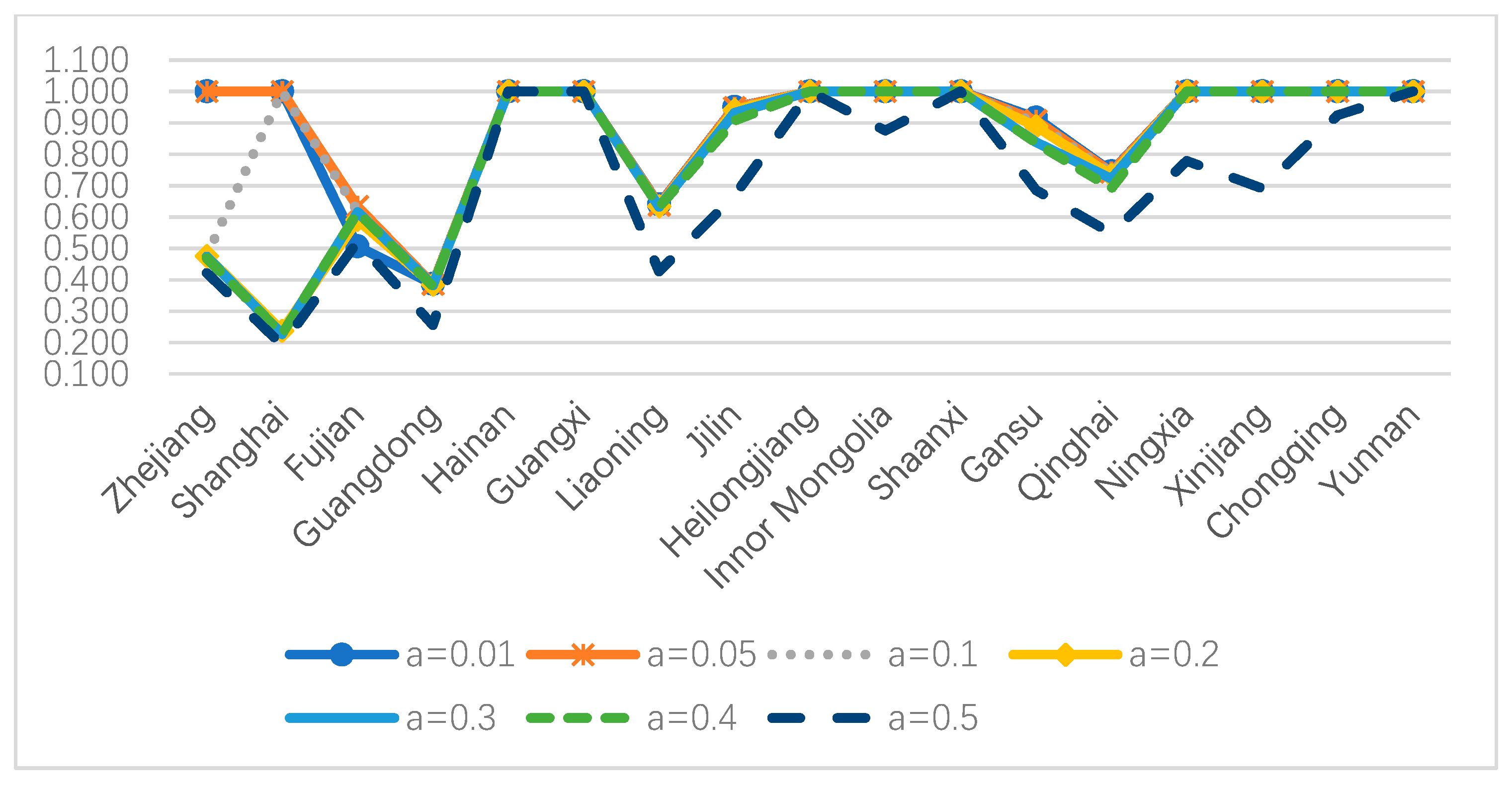
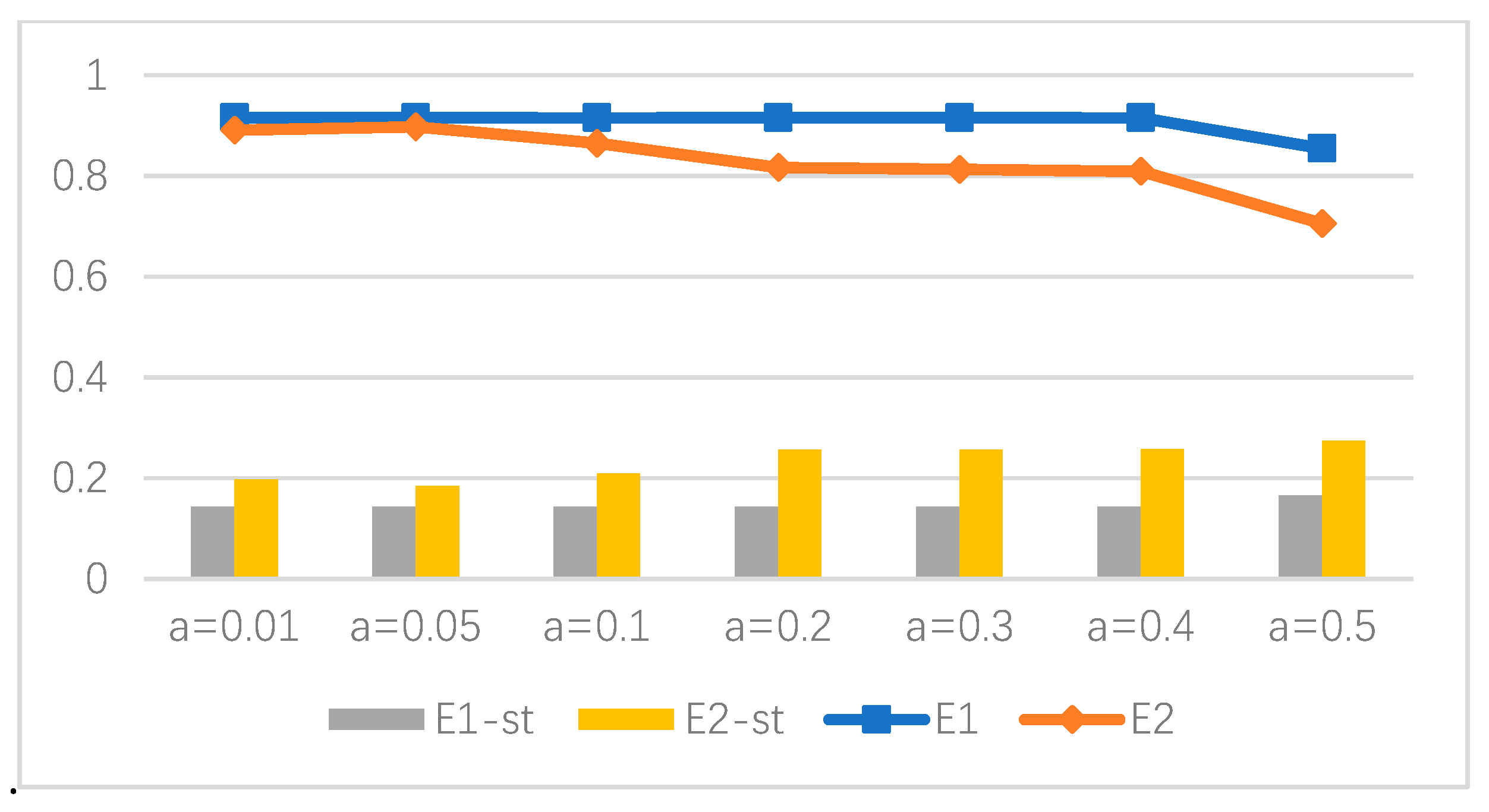
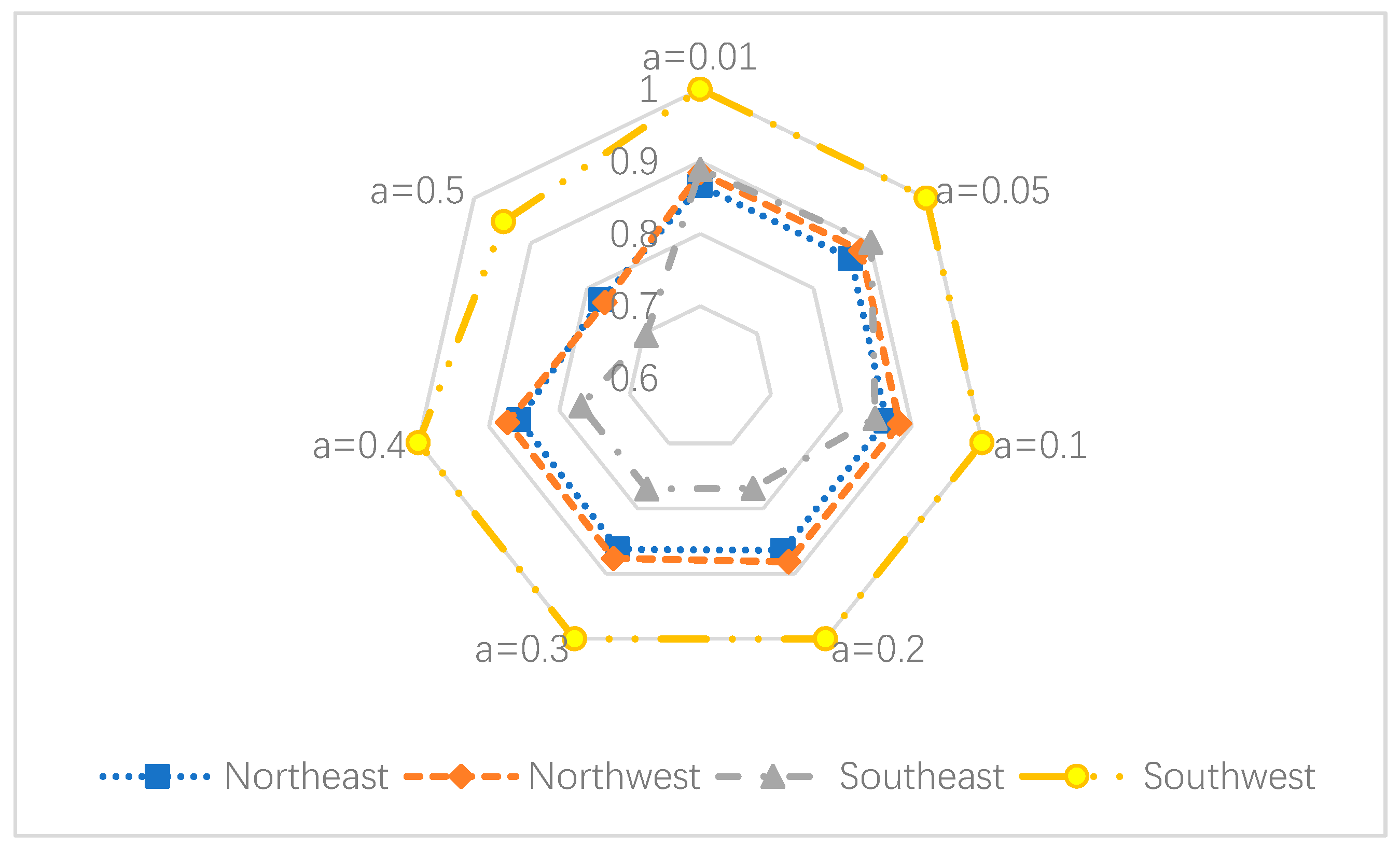
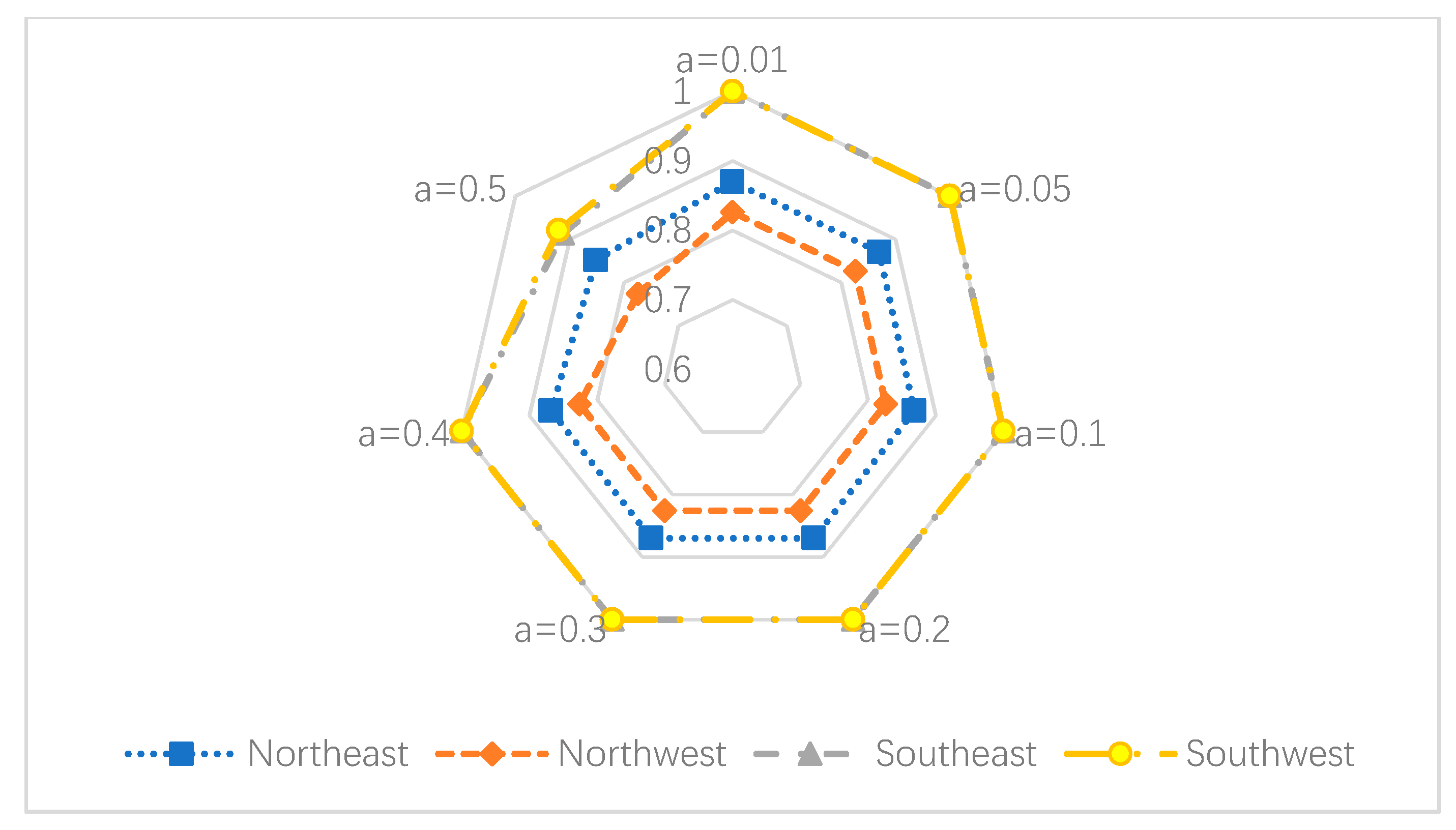
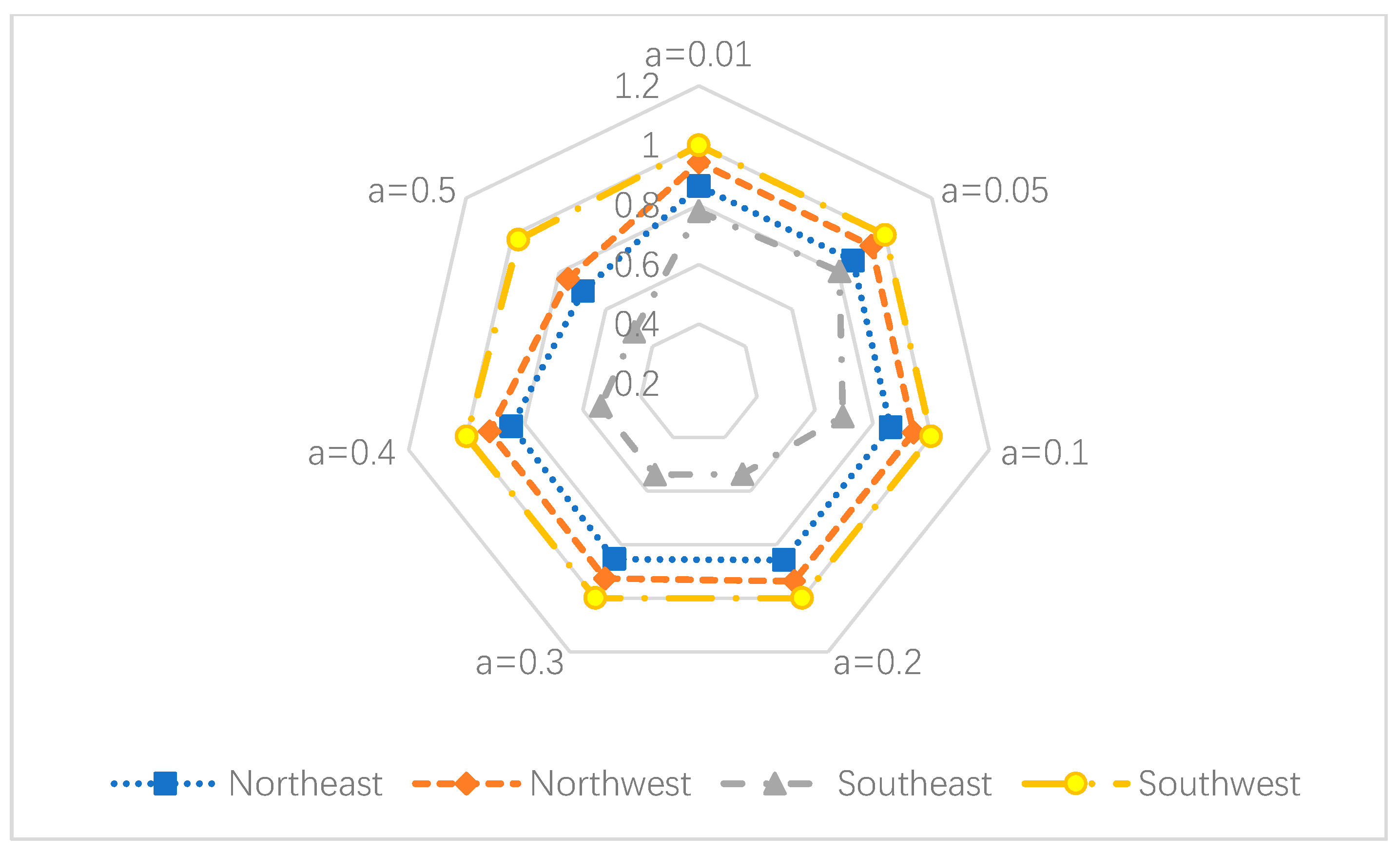
| Variables | Min | Max | Mean | S.T | |
|---|---|---|---|---|---|
| Stage 1 | Labor (1,000,000 persons) | 12.22 | 269.44 | 95.65 | 62.21 |
| Fixed assets investment (100 billion RMB) | 11.64 | 1463.8 | 257.1 | 355.3 | |
| Total industrial energy consumption (1,000,000 TCE) | 9.86 | 175.76 | 74.91 | 48.36 | |
| Gross industrial production (100 billion RMB) | 479.22 | 31,539.6 | 7451.4 | 7580.8 | |
| Intermediate output | Industrial waste gas production (1,000,000 Ton) | 4.15 | 53.18 | 21.59 | 11.94 |
| Stage 2 | Annual expenditure for operation (1,000,000 RMB) | 1032.3 | 10,460.6 | 4489.2 | 2945.8 |
| Industrial waste gas removal (1,000,000 Ton) | 4,04 | 50.60 | 20.48 | 11.33 |
| Region | ||||||
|---|---|---|---|---|---|---|
| Zhejiang | 0.633 (14) | 0.844 (11) | 0.422 (15) | 1.000 (1) | 1.000 (1) | 1.000 (1) |
| Shanghai | 0.597 (16) | 1.000 (1) | 0.193 (1) | 1.000 (1) | 1.000 (1) | 1.000 (1) |
| Fujian | 0.724 (10) | 0.927 (9) | 0.521 (13) | 0.817 (13) | 1.000 (1) | 0.633 (16) |
| Shandong | 0.628 (15) | 1.000 (1) | 0.256 (16) | 0.693 (16) | 1.000 (1) | 0.386 (17) |
| Hainan | 0.897 (5) | 0.794 (12) | 1.000 (1) | 1.000 (1) | 1.000 (1) | 1.000 (1) |
| Guangxi | 1.000 (1) | 1.000 (1) | 1.000 (1) | 1.000 (1) | 1.000 (1) | 1.000 (1) |
| Liaoning | 0.642 (12) | 0.857 (10) | 0.427 (14) | 0.749 (15) | 0.861 (13) | 0.638 (15) |
| Jilin | 0.834 (9) | 1.000 (1) | 0.668 (11) | 0.974 (10) | 1.000 (1) | 0.949 (12) |
| Heilongjiang | 0.849 (8) | 0.698 (14) | 1.000 (1) | 0.875 (11) | 0.749 (14) | 1.000 (1) |
| Inner Mongolia | 0.938 (4) | 1.000 (1) | 0.875 (7) | 1.000 (1) | 1.000 (1) | 1.000 (1) |
| Shaanxi | 0.965 (2) | 0.930 (8) | 1.000 (1) | 1.000 (1) | 1.000 (1) | 1.000 (1) |
| Gansu | 0.646 (11) | 0.606 (15) | 0.686 (10) | 0.799 (14) | 0.690 (15) | 0.907 (13) |
| Qinghai | 0.540 (17) | 0.533 (17) | 0.547 (12) | 0.678 (17) | 0.613 (17) | 0.742 (14) |
| Ningxia | 0.889 (6) | 1.000 (1) | 0.779 (8) | 1.000 (1) | 1.000 (1) | 1.000 (1) |
| Xinjiang | 0.633 (13) | 0.576 (16) | 0.691 (9) | 0.827 (12) | 0.654 (16) | 1.000 (1) |
| Chongqing | 0.962 (3) | 1.000 (1) | 0.925 (6) | 1.000 (1) | 1.000 (1) | 1.000 (1) |
| Yunnan | 0.881 (7) | 0.762 (13) | 1.000 (1) | 1.000 (1) | 1.000 (1) | 1.000 (1) |
| Average | 0.780 | 0.855 | 0.705 | 0.907 | 0.916 | 0.897 |
| Region | Overall Efficiency | s.t | ||||||
|---|---|---|---|---|---|---|---|---|
| Zhejiang | 1.000 | 1.000 | 0.738 | 0.738 | 0.737 | 0.735 | 0.633 | 0.144 |
| Shanghai | 1.000 | 1.000 | 1.000 | 0.618 | 0.613 | 0.613 | 0.597 | 0.208 |
| Fujian | 0.753 | 0.817 | 0.810 | 0.795 | 0.808 | 0.808 | 0.724 | 0.035 |
| Guangdong | 0.693 | 0.693 | 0.693 | 0.692 | 0.691 | 0.690 | 0.628 | 0.024 |
| Hainan | 1.000 | 1.000 | 1.000 | 1.000 | 1.000 | 1.000 | 0.897 | 0.039 |
| Guangxi | 1.000 | 1.000 | 1.000 | 1.000 | 1.000 | 1.000 | 1.000 | 0.000 |
| Liaoning | 0.750 | 0.749 | 0.745 | 0.747 | 0.747 | 0.743 | 0.642 | 0.040 |
| Jilin | 0.975 | 0.974 | 0.973 | 0.970 | 0.966 | 0.953 | 0.834 | 0.051 |
| Heilongjiang | 0.875 | 0.875 | 0.875 | 0.875 | 0.875 | 0.875 | 0.849 | 0.010 |
| Inner Mongolia | 1.000 | 1.000 | 1.000 | 1.000 | 1.000 | 1.000 | 0.938 | 0.024 |
| Shaanxi | 1.000 | 1.000 | 1.000 | 1.000 | 1.000 | 1.000 | 0.965 | 0.013 |
| Gansu | 0.803 | 0.799 | 0.794 | 0.789 | 0.764 | 0.763 | 0.646 | 0.055 |
| Qinghai | 0.679 | 0.678 | 0.676 | 0.673 | 0.667 | 0.652 | 0.540 | 0.050 |
| Ningxia | 1.000 | 1.000 | 1.000 | 1.000 | 1.000 | 1.000 | 0.889 | 0.042 |
| Xinjiang | 0.827 | 0.827 | 0.827 | 0.827 | 0.827 | 0.827 | 0.633 | 0.073 |
| Chongqing | 1.000 | 1.000 | 1.000 | 1.000 | 1.000 | 1.000 | 0.962 | 0.014 |
| Yunnan | 1.000 | 1.000 | 1.000 | 1.000 | 1.000 | 1.000 | 0.881 | 0.045 |
| Average | 0.903 | 0.907 | 0.890 | 0.866 | 0.864 | 0.862 | 0.780 | - |
| Number of efficient DMU | 9 | 9 | 8 | 7 | 7 | 7 | 1 | - |
| Region | Efficiency | ||||||
|---|---|---|---|---|---|---|---|
| Zhejiang | 0.775 | 0.773 | 0.773 | 0.773 | 0.773 | 0.773 | 0.773 |
| Shanghai | 0.843 | 0.841 | 0.841 | 0.841 | 0.841 | 0.841 | 0.841 |
| Fujian | 1.000 | 1.000 | 1.000 | 0.954 | 0.952 | 0.950 | 0.947 |
| Guangdong | 1.000 | 1.000 | 1.000 | 1.000 | 1.000 | 1.000 | 1.000 |
| Hainan | 0.740 | 0.731 | 0.726 | 0.719 | 0.714 | 0.708 | 0.703 |
| Guangxi | 1.000 | 1.000 | 1.000 | 1.000 | 1.000 | 1.000 | 1.000 |
| Liaoning | 0.811 | 0.811 | 0.811 | 0.811 | 0.811 | 0.811 | 0.810 |
| Jilin | 1.000 | 1.000 | 1.000 | 1.000 | 1.000 | 1.000 | 1.000 |
| Heilongjiang | 1.000 | 1.000 | 1.000 | 1.000 | 1.000 | 1.000 | 1.000 |
| Inner Mongolia | 1.000 | 1.000 | 1.000 | 1.000 | 1.000 | 1.000 | 1.000 |
| Shaanxi | 1.000 | 1.000 | 1.000 | 1.000 | 1.000 | 1.000 | 1.000 |
| Gansu | 0.814 | 0.805 | 0.799 | 0.792 | 0.787 | 0.782 | 0.766 |
| Qinghai | 0.674 | 0.655 | 0.640 | 0.629 | 0.624 | 0.620 | 0.617 |
| Ningxia | 1.000 | 1.000 | 1.000 | 1.000 | 1.000 | 1.000 | 1.000 |
| Xinjiang | 1.000 | 1.000 | 1.000 | 1.000 | 1.000 | 1.000 | 1.000 |
| Chongqing | 1.000 | 1.000 | 1.000 | 1.000 | 1.000 | 1.000 | 1.000 |
| Yunnan | 1.000 | 1.000 | 1.000 | 0.935 | 0.914 | 0.895 | 0.871 |
| Average | 0.921 | 0.919 | 0.917 | 0.909 | 0.907 | 0.905 | 0.902 |
| Number of efficient DMU | 11 | 11 | 11 | 9 | 9 | 9 | 9 |
© 2020 by the authors. Licensee MDPI, Basel, Switzerland. This article is an open access article distributed under the terms and conditions of the Creative Commons Attribution (CC BY) license (http://creativecommons.org/licenses/by/4.0/).
Share and Cite
Wang, M.; Chen, Y.; Zhou, Z. A Novel Stochastic Two-Stage DEA Model for Evaluating Industrial Production and Waste Gas Treatment Systems. Sustainability 2020, 12, 2316. https://doi.org/10.3390/su12062316
Wang M, Chen Y, Zhou Z. A Novel Stochastic Two-Stage DEA Model for Evaluating Industrial Production and Waste Gas Treatment Systems. Sustainability. 2020; 12(6):2316. https://doi.org/10.3390/su12062316
Chicago/Turabian StyleWang, Meiqiang, Yingwen Chen, and Zhixiang Zhou. 2020. "A Novel Stochastic Two-Stage DEA Model for Evaluating Industrial Production and Waste Gas Treatment Systems" Sustainability 12, no. 6: 2316. https://doi.org/10.3390/su12062316





